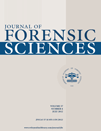The Identification of Two Unusual Types of Homemade Ammunition*
Sponsored in part by the National Science Council of the Republic of China (Taiwan) under Contract No. NSC 95-2414-H-015-005.
Abstract
Abstract: Illegal homemade ammunition is commonly used by criminals to commit crimes in Taiwan. Two unusual types of homemade ammunition that most closely resembling genuine ammunition are studied here. Their genuine counterparts are studied as the control samples for the purpose of comparison. Unfired ammunition is disassembled, and the morphological, dimensional, and compositional features of the bullet and cartridge case are examined. Statistical tests are employed to distinguish the dimensional differences between homemade and genuine ammunitions. Manufacturing marks on head stamps of the cartridge case are carefully examined. Compositional features of propellant powders, primer mixtures, and gunshot residues are also analyzed. The results reveal that the morphological, dimensional, and compositional features of major parts of the ammunition can be employed to differentiate homemade cartridges from genuine ones. Among these features, tool marks on the head stamps left by the bunter can be used to trace the origin of ammunition.




